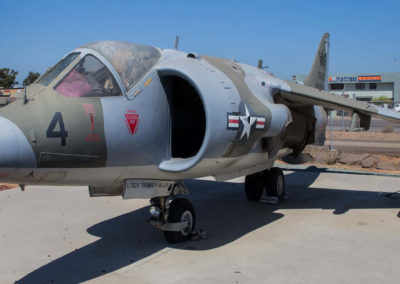AV-8A Harrier
The Harrier is a family of jet-powered attack aircraft capable of vertical/short takeoff and landing operations (V/STOL). Named after a bird of prey, it was originally developed by British manufacturer Hawker Siddeley in the 1960s.
Warbird Overview
The Harrier is a family of jet-powered attack aircraft capable of vertical/short takeoff and landing operations (V/STOL). Named after a bird of prey, it was originally developed by British manufacturer Hawker Siddeley in the 1960s. The Harrier emerged as the only truly successful V/STOL design of the many attempted during that era. It could operate from improvised bases with little improvement and later aircraft carriers.
ABOUT THE AV-8A HARRIER
The Harrier is a family of jet-powered attack aircraft capable of vertical/short takeoff and landing operations (V/STOL). Named after a bird of prey, it was originally developed by British manufacturer Hawker Siddeley in the 1960s. The Harrier emerged as the only truly successful V/STOL design of the many attempted during that era. It could operate from improvised bases with little improvement and later aircraft carriers. There are two generations and four main variants of the Harrier family, developed by both UK and US manufacturers:
- Hawker Siddeley Harrier
- British Aerospace Sea Harrier
- McDonnell Douglas AV-8B Harrier II
- British Aerospace Harrier II
The Hawker Siddeley Harrier is the first generation-version and is also known as the AV-8A Harrier; it was used by multiple air forces, including the Royal Air Force (RAF) and the United States Marine Corps (USMC).
Our Harrier is the 4th of 12 Harrier 50s purchased from Hawker-Siddeley in the UK by the US Navy for evaluation for the US Marine Corps. It is 1 of 3 remaining.
Fact #1
This aircraft was one of the original four Full Scale Development (FSD) aircraft built in the United Kingdom and delivered to the US Marine Corps.
Fact #2
After serving with the Marine Corps for several years it was transferred to NASA in California as Vertical Short Take-Off and Landing (VSTOL) testbed.
Fact #3
Harriers have been used not only as a ground attack aircraft but also in the role of Forward Air Controller Airborne (FAC(A))
Manufacturer: Hawker-Siddeley
Crew: One
Length: 47 ft 2 in
Wingspan: 25 ft 3 in (7.70 m)
Height: 11 ft 4 in (3.45 m)
Empty Weight: 12,200 lb (5,530 kg)
Maximum take-off weight (short takeoff): 26,000 lb (11,800 kg)
Max speed: 731 mph (1,176 km/h)
Combat radius: 200 nmi
Engine: Pegasus 11 Mk 101
Thrust: 21,800 lbf (97.0 kN)
The aircraft (FL 41H) was constructed in 1970 in England at the Hawker-Siddeley Factory first flew on 16 February 1971. On 12 March 1971 it was taken on strength on charge with the Royal Air Force (marked as XW647). It was then delivered to Patuxent River NAS and on 16 March 1971, Taken on Strength/Charge with the United States Marine Corps with BuNo 158387 as a AV-8A and operated within markings of VMA-513, WF, 158387. On 19 March 1971, it was redesignated as a JAV-8A. On April 15, it became an AV-8A and then the next day sent to VMA-513 Beaufort, On 27 July 1973, it was transferred to VMA-231 Cherry Point NAS, On 28 May 1975, it was transferred to NARF Cherry Point. On 19 January 1977, it was transferred to AFPRO Saint Louis, Missouri. In February 1979, it was transferred to NATC RDT and E at Patuxent River NAS. In June 1979, it was converted to an AV-8C. In November 1979, it was transferred to VX-5 China Lake In January 1980, it was transferred to AFPRO Saint Louis. On 9 May 1980, it was transferred to NATC RDT and E Patuxent River NAS. In September 1980, it was redesignated as JAV-8C. In 1981, it was converted to an AV-8C. Around 1990, the jet joined National Aeronautics and Space Administration (NASA) as NASA 719 receiving US Civil Registration N719NA. In 1996, it was struck from active operations, returned to the National Naval Aviation Museum, but was soon loaned again to NASA and this time went to NASA Ames Exploration Center, Moffett Field, San Francisco, CA. The aircraft was displayed at Hiller Aviation Museum in San Diego in 2005. The aircraft departed NASA service in 2007. In 2008, the aircraft went to the Flying Leatherneck Aviation Museum at Miramar MCAS, CA. Repainted in Marine Corps markings in 2009. In April 2021, it was relocated to Texas by Fort Worth Aviation Museum. This aircraft is on loan from the National Naval Aviation Museum in Pensacola, Florida.
Good shape and will need a good wash and brush down.
Note: Scheduling is always a moving target depending on weather and workload. All schedules are subject to changes.
Become a Member!
FLIGHT SIMULATOR
Events
Events
HOURS
Saturday: 9AM-2PM
Sunday: 11AM-3PM


